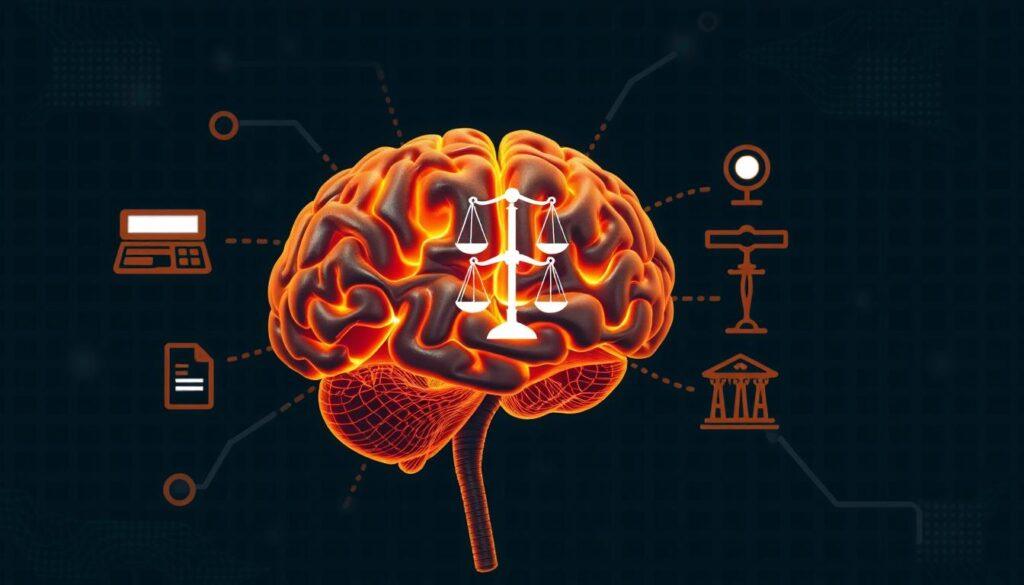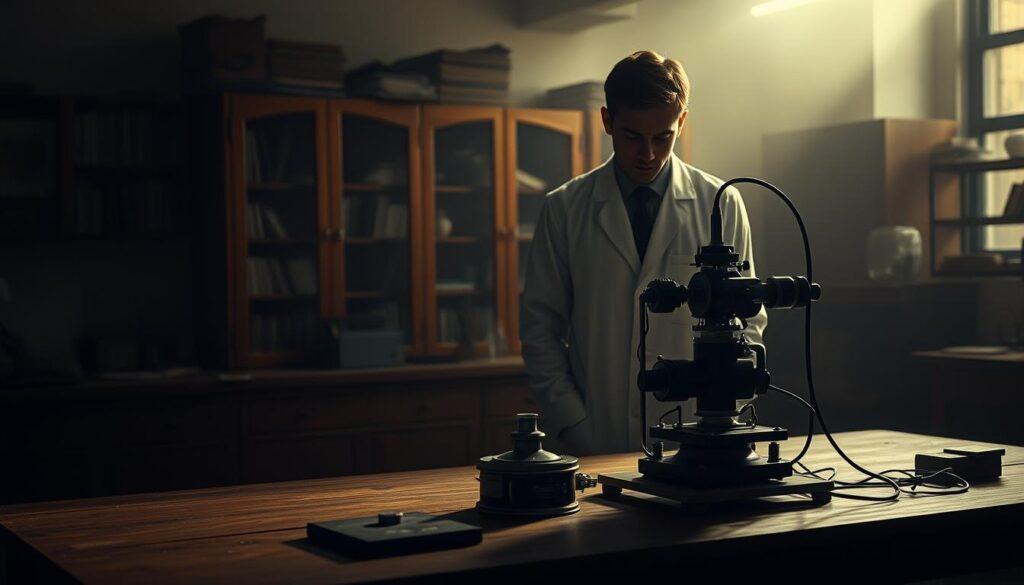Ever shared an idea and got blank stares? This is the curse of knowledge mental model. It’s a cognitive bias where experts think everyone knows what they do.
First spotted in a 1989 Journal of Political Economy study by Colin Camerer, George Loewenstein, and Martin Weber, it blocks clear communication in teaching, marketing, and talks.
A 1990 study by Elizabeth Newton is a clear example. Tappers thought listeners would guess songs 50% of the time. But, only 2.5% got it right. This shows how knowing too much can make us miss others’ views.
Teachers, marketers, and engineers all struggle with this. Science communicators might use too much jargon, and UX designers might miss user confusion. Even teachers can think students know more than they do.
The curse of knowledge isn’t just in school—it’s a daily challenge to communicate well.
Key Takeaways
- The curse of knowledge mental model describes how experts assume others know what they know.
- Coined in 1989 by economists, it explains why clear explanations often fail.
- Elizabeth Newton’s experiment showed tappers overestimated listener understanding by 20x.
- Teachers and communicators face this bias daily, creating misunderstandings.
- Strategies like formative assessments and user testing can reduce this knowledge gap.
Understanding the Curse of Knowledge Mental Model
Imagine trying to explain a complex idea to someone who knows nothing about it. The curse of knowledge mental model explains why this is harder than you think. This bias, rooted in psychology, makes experts assume others share their expertise.
Let’s explore its roots and how it shapes decisions.
Definition and Origins
First identified in 1975 by psychologist Baruch Fischhoff, the concept became central to psychology curse of knowledge research. In 1990, Elizabeth Newton’s study revealed a stark reality: tappers guessed listeners would recognize 50% of songs, but only 2.5% were correct.
This gap shows how knowledge distorts communication, trapping speakers in their own expertise.
How the Curse of Knowledge Develops
As you gain expertise, your brain discards early learning steps. Teachers often overestimate student readiness, while doctors may use jargon patients don’t understand. Fischhoff’s work showed people can’t “unlearn” knowledge, making simplifying ideas feel unnatural.
Even warned about the bias, participants in studies struggled to adjust, proving its grip on decision making bias.
Related Cognitive Biases
This bias ties to hindsight bias (“I knew it all along”) and the Dunning-Kruger effect. Studies show professionals in medicine and education consistently overestimate others’ knowledge, creating gaps in classrooms and boardrooms.
Awareness alone isn’t enough—overcoming it requires deliberate effort.
How the Curse of Knowledge Affects Your Communication
Imagine trying to explain something you know well, but your audience doesn’t get it. This communication breakdown occurs because experts often forget their own knowledge gap.
A famous study showed that tappers thought listeners would recognize 50% of songs, but listeners only got 2.5%. This mirrors real-world issues, like Dropbox’s early marketing mistake.
Their first video assumed people knew about cloud storage, confusing many. A new video with simple stories fixed this information asymmetry, attracting millions of users.

Overestimating Others’ Understanding
When you’re deep in your field, you forget others aren’t. Doctors face this every day: patients who don’t understand diagnoses often skip treatments, making things worse.
The knowledge gap isn’t just about jargon—it’s about assuming others know as much as you do.
Using Jargon and Technical Language
“You’ve had years of immersion in the logic of your field,” explain Dan and Chip Heath. “Yet your audience hasn’t.”
Stephen Pinker says, “Writers assume readers know jargon and logic steps obvious to them.” This creates barriers between experts and their audience.
A 2007 study found experts’ mental models become so abstract they can’t simplify. This leads to confusion for listeners.
The Empathy Gap in Explanation
Imagine explaining car mechanics to someone who’s never seen an engine. You’d forget their starting point—a flaw studies call the “curse of expertise.”
In healthcare, this empathy gap causes non-compliance. Patients who don’t understand treatments cost systems billions each year. Without bridging this gap, communication fails.
Real-World Examples of the Curse of Knowledge
Imagine trying to explain a complex idea to someone new to your field. The curse of knowledge bias makes this hard. A famous 1990 Stanford study showed a big gap in understanding. Tappers thought listeners would get 50% of songs by taps, but only 2.5% were right.
This shows how being an expert can lead to a communication breakdown. It’s like having a blind spot.
| Field | Scenario | Impact |
|---|---|---|
| Education | Professors skipping basics | 50% of students confusion |
| Technology | Unclear technical manuals | 40% rise in support calls |
| Healthcare | Medical jargon use | 30% patient misunderstandings |
Technical writers often struggle with this. Programmers might skip code comments, thinking others will understand. In marketing, using too much jargon can scare off 60% of customers.
Even lawyers lose clients if they use terms only other lawyers get.
These issues aren’t just about understanding. They cost time, trust, and chances to succeed.
“The mind that makes a decision is not the same as the mind that explains it,”
wrote Daniel Kahneman inThinking, Fast and Slow. This shows why experts need to simplify. A 2020 study found 87% of professionals know they should simplify but find it hard.
Want to learn more? Check out how mental models affect communication atAbout Mental Models. The first step to fixing these problems is to recognize your own blind spots.
Then, learn to speak in a way your audience can understand.
The Psychology Behind the Curse of Knowledge Bias

Thepsychology curse of knowledgecomes from gaining expertise. It changes how we think, making it hard to remember what it’s like to start from scratch. As we become experts, our brains use shortcuts that hide the basics. Thispsychology curse of knowledgeis due to how our brains work, like neural pruning, making familiar things automatic.
Cognitive Mechanisms at Work
A 1990 study by Elizabeth Newton showed a big gap in communication. Experts think listeners know more than they do, by 20 times. As we get better at something, our brains focus on speed over clarity. This makes it hard for others to understand the basics.
Information Asymmetry and Its Consequences
Experts often assume everyone knows what they do. This leads to confusion in schools and businesses. It’s not that they mean to confuse people—it’s just how their brains work. Even knowing about the bias, it’s hard to change how we think.
Why Experts Struggle to Simplify
Experts find it hard to explain things simply because their knowledge is so deep. It’s like their brain’s pathways for expertise are invisible. Kids, on the other hand, naturally ask questions. T
o overcome this, experts should test their explanations and listen to feedback. It’s a challenge, but there are ways to make things clearer.
How to Recognize When You’re Suffering from the Curse of Knowledge
Spotting the curse of knowledge bias starts with noticing how others react to you. If people keep asking you to explain things again, or if they say they’re confused, it’s a sign.
These are red flags that your knowledge gap is causing problems.
Warning Signs in Your Communication
If you use technical terms without explaining them, or skip basic steps in your explanations, you might be suffering from this bias. A professor might think students understand something when they don’t. This can really hurt learning.
Studies show experts often think others know more than they do. For example, in one study, people incorrectly rated containers when they thought they shared knowledge. Research shows this can lead to a 34% drop in understanding compared to when everyone knows the basics.
Feedback Patterns That Indicate a Problem
Look out for feedback like: “What does ‘synergy’ mean here?” or “You lost me at step three.” These hints show there’s a gap between your knowledge and others’.
When teams ignore simple questions, it’s a sign of a growing knowledge gap.
| Condition | Red Container Rating |
|---|---|
| Ignorance | 71% |
| Knowledge-Plausible | 34% |
| Knowledge-Implausible | 19% |
The Feynman Technique, mentioned in decision-making frameworks, suggests simplifying ideas to find gaps.
If your explanations confuse people, it’s time to rethink how you’re sharing your knowledge. Spotting these signs early helps avoid misunderstandings and improves teamwork and teaching.
Practical Strategies to Overcome the Expert Blind Spot
Starting to fight the expert blind spot means first acknowledging it exists. The *Decoding the Disciplines* framework helps by making complex knowledge simple. Ask yourself: “What assumptions am I making about my audience’s baseline understanding?”
A 2020 study on programming education found 16,791 novice explanations. These showed what experts often miss. Researchers noted:
“Instructors’ assumptions about what’s ‘obvious’ often clash with learners’ real struggles.”
Their learnersourcing system showed that beginner views can improve teaching materials.
Storytelling makes complex ideas easy to understand. Explain algorithms like baking instructions: “Loops are like recipe steps—each iteration builds the final product.” Use simple language instead of jargon.
Microsoft’s Satya Nadella changed the company by focusing on empathy over just being an expert.
Test your explanations by getting feedback. Ask non-experts to explain your points back to you. If they struggle, make it simpler. General Motors CEO Mary Barra did this during the 2014 recall crisis, showing her willingness to learn.
Keeping a “beginner’s mind” helps keep your communication clear. Harvard’s research shows 84% of leaders think they know themselves better than they do. So, actively look for your blind spots every week.
The curse of knowledge mental model hides in silence, but these strategies turn those gaps into chances to learn.
Conclusion: Becoming a More Effective Communicator by Managing the Curse of Knowledge
The curse of knowledge bias often sneaks into conversations without us noticing. It leads to communication breakdown between experts and audiences. You’ve seen how this mental model impacts workplace discussions and teaching methods.
Stephen Pinker’s advice is clear: treat your audience as equally capable but less informed. When 70% of non-experts struggle with technical jargon, simplifying language is key. It’s about building bridges to understanding.
Imagine a teacher who uses visual aids, boosting retention by 50%. Or a team that adopts peer learning, improving comprehension by 25%. These strategies turn barriers into opportunities.
Combatting this bias starts with humility. Research shows experts with higher humility adapt explanations better. Those clinging to expertise risk inflexibility. Ask for feedback, test ideas with diverse audiences, and embrace iterative learning.
Remember, 80% of communication breakdowns stem from knowledge mismatches. Closing that gap means better teamwork, clearer teaching, and stronger relationships.
Think of this as a skill, not a one-time fix. Over time, these efforts turn into habits that make you a more empathetic, relatable communicator—no matter your field.


